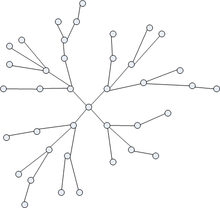Terminal (telecommunication)
Appearance
This article has multiple issues. Please help improve it or discuss these issues on the talk page. (Learn how and when to remove these template messages)
|

In the context of telecommunications, a terminal is a device which ends a telecommunications link and is the point at which a signal enters or leaves a network. Examples of terminal equipment include telephones, fax machines, computer terminals, printers and workstations.
An end instrument is a piece of equipment connected to the wires at the end of a telecommunications link. In telephony, this is usually a telephone connected to a local loop. End instruments that relate to data terminal equipment include printers, computers, barcode readers, automated teller machines (ATMs) and the console ports of routers.[1][2]
See also
References
- ^ Gnanasivam, P. (2005). Telecommunication switching and networks. New Delhi: New Age International. ISBN 81-224-1583-0. OCLC 762016601.
- ^ P. Gnanasivam (2005). Telecommunication Switching and Networks. New Age International. pp. 26–. ISBN 978-81-224-1583-4.
External links
